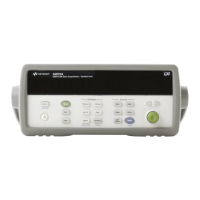5 Theory of Operation
140 Keysight 34970A/34972A Service Guide
In the DC current function, a current is applied between the Input I and LO
terminals. Ranging is accomplished by relay K102 and amplifier gain switching in
U101. Since a known resistor (the shunt resister) is connected between these
terminals, a voltage proportional to the unknown current is generated. The
voltage sensed at R121 is measured by the multimeter’s DC circuitry. The table
below illustrates the DC current measuring function configurations.
Resistance measurements are made by applying a known current through an
unknown resistance. The resulting voltage drop across the unknown resistance is
then measured by the multimeter’s DC circuitry. The 100 MW range is measured
using the known internal 10 MW resistance (U102A) in parallel with the unknown
input resistance while applying the 500 nA current source. The result is computed
from the measured data. The internal 10 MW resistance is determined whenever a
zero calibration is performed.
In the 2-wire ohms function, the voltage drop is measured across the Input HI and
Input LO terminals. In the 4-wire ohms function, the voltage is measured across
the HI Sense and LO Sense terminals. Lead resistances in series with the current
source (Input HI–LO) are not part of the final measurement. However, they do
reduce the available current source compliance voltage for the resistor under test.
The ohms current source will become non-linear when the compliance voltage
limit is exceeded. The full scale voltage developed across the unknown resistor
and the DC amplifier gain for each resistance range are tabulated below.
DCI Range Shunt Resistor U101-10 Input Amplifier Gain ADC Input
1A
100 mA
10 mA
0.1W
5.1W
5.1W
100 mV
510 mV
51 mV
x100
x10
x100
10 V
5.1 V
5.1 V
Ohms Range Voltage Across R Amplifier Gain ADC Input
100 W
1 kW to 100 kW
1 MW
10 MW
100 MW
100 mV
1 V
5 V
5 V
4.5 V
x100
x10
x1
x1
x1
10 V
10 V
5 V
5 V
4.5 V

